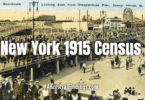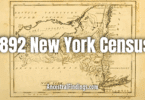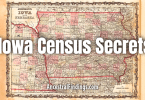We’ve made it to the 1910 census, and I have to say, this one feels like a bit of a turning point. If you’ve been following along through each census with me, you’ve probably noticed how much the country has been changing—and how those changes show up in the records. The 1900 census gave us a lot, but the 1910 one steps things up in a way that’s easy to miss unless you sit with it.
What’s always fascinated me about these records is how they stop being just lists of names when you start reading between the lines. You begin to see the stories. You see families grow, move, lose someone, gain someone. You start noticing how many mothers answered heartbreaking questions about how many children they had and how many were still living. Or how people changed jobs—or didn’t—and what that might’ve meant. These records speak if you know how to listen.
So whether you’re deep into your family tree or curious about what these old government forms can reveal, the 1910 census is worth exploring. It holds more than you might expect. Let’s look at what makes it unique, what new information you’ll find, and how it can help you bring your ancestors’ stories to life.
The Historical Setting
The 1910 U.S. Census was officially taken on April 15, 1910. This census marked the 13th enumeration of the population and reflected a nation amid dramatic growth and transition. America in 1910 was full of movement—immigrants pouring in, industrial centers expanding, and families shifting from farms to cities. That shifting landscape makes this census especially important when tracing people who may have disappeared from earlier locations or changed their circumstances.
What Was Asked in the 1910 Census
One key aspect of this census is how it expanded on the information gathered in 1900. The government didn’t overhaul the whole system, but they did refine some questions and add others that give us even more insight. If you’re tracing people through time, this census offers a crucial middle step between the 1900 and 1920 enumerations.
Marital information wasn’t limited to whether someone was married, single, or widowed. Enumerators were instructed to record how many years a person had been married and whether it was their first or second marriage. For genealogists, this can help confirm timelines and uncover earlier undocumented unions. For women, there was also a question about how many children they had given birth to and how many were still living.
The census also asked about nativity: where each person was born and the birthplace of their parents. This remained consistent with previous censuses, but it became particularly useful in the 1910 census as immigrant waves had been swelling since the 1880s.
Special Features of the 1910 Census
One of the unique questions in 1910 was whether a person was a survivor of the Union or Confederate Army or Navy. This Civil War-related question can be a goldmine, especially for descendants of veterans who don’t appear in pension records.
Occupational questions were also expanded. The 1910 census asked not only what someone’s job was but also the industry they worked in and whether the individual was an employer, employee, or self-employed.
Language was another new feature. For those born outside the U.S., the census asked what language they spoke and whether they could speak English. This is particularly useful for tracing assimilation or cultural enclaves.
The housing questions asked whether homes were owned or rented and whether they were mortgaged. This can sometimes be matched with land records or city directories to build a fuller picture of your ancestor’s financial situation.
Research Tips for Using the 1910 Census
A tip worth sharing: neighbors matter. The 1910 census can be used to reconstruct entire communities. Once you find your ancestor, scan the names on the same page and nearby pages. You might discover extended family living nearby—especially married daughters or siblings.
It’s also good to know about common transcription issues. Names may be recorded phonetically, especially if the family spoke limited English. Spelling variations and incorrect ages are common. Try using wildcards in your search or narrowing down by first name, age range, and birthplace.
The 1910 census had some quirks. For example, some microfilm copies include red-coded notations that were added later for classification purposes. These marks might add detail to occupations or dwelling types.
Another often-overlooked detail: the census was supposed to count every person where they actually lived on April 15, not where they happened to be when the enumerator came. If someone is missing from one household but found in another, check to see if they were staying with relatives, in a hospital, or boarding elsewhere.
Insights for African American Genealogy
For African American researchers, the 1910 census is significant. It continued the fuller enumeration that began after emancipation, giving a more complete view of Black families nationwide. Combined with earlier censuses and local records, it becomes a crucial puzzle piece.
Context for Military and Historical Events
The 1910 census was also the last federal count before World War I. Many men listed would serve in the military within just a few years. The elderly ancestors you find here may not appear in 1920, so this might be their final census glimpse.
Making the Most of the 1910 Census
All in all, the 1910 census is one of the richest when it comes to practical, day-to-day details. It helps fill in those early 20th-century gaps with data that breathes life into the names on your family tree.
This census offers a solid checkpoint if you’re keeping notes or building timelines. Look for changes in family structure, like children growing up and moving out or new babies joining the household. Look for employment patterns, housing shifts, or signs of economic ups and downs. Most of all, it should be used as an invitation to ask more questions. Where did they go next? What happened to them in the next ten years? Who came into their lives or left it?
That’s the magic of the 1910 census—a snapshot of a family in motion, caught just long enough for us to see them, ask about them, and maybe even understand them better.






